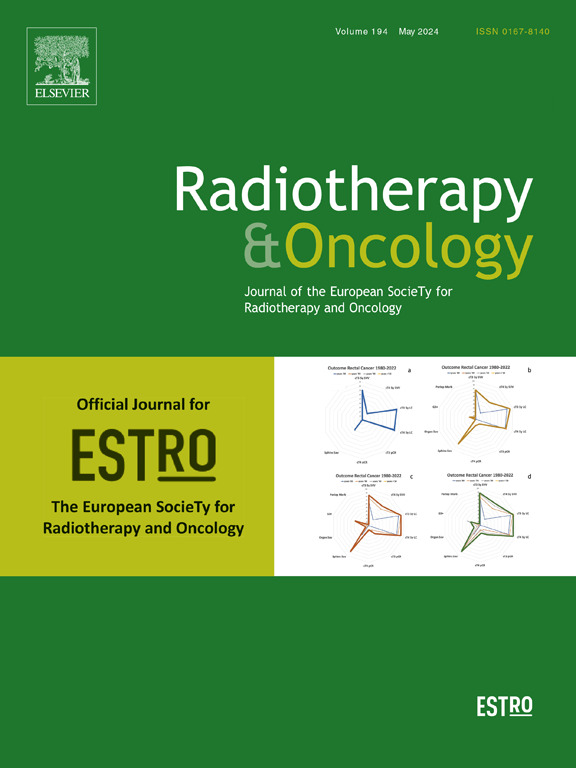Role of consolidative thoracic and prophylactic cranial radiation in extensive stage small cell lung cancer in chemo-immunotherapy era
IF 4.9
1区 医学
Q1 ONCOLOGY
引用次数: 0
Abstract
Introduction
The role of consolidative thoracic and prophylactic brain radiation for extensive stage small cell lung cancer patients is controversial. We investigated the factors associated with the use of any radiation therapy (RT) and whether RT has a benefit to overall survival (OS) in patients receiving any systemic therapy and whether this benefit is the same if Chemotherapy (CT) or chemo-immunotherapy (CT-IO) is used.
Material/Methods
The NCDB database was queried from years 2017–2019. Patients receiving systemic therapy- STX (CT or CT-IO) had to have at least 6 months of follow-up and have no brain metastases at diagnosis. All RT patients had to receive upfront systemic therapy, be treated 2–6 months from diagnosis, and if treated to the brain received 25 Gy in 10 fractions only. Multi-variable analyses (MVA) were used to determine factors associated with OS and selection for any radiation. Propensity matching for factors affecting OS were used to generate Kaplan-Meier OS curves. Log-rank tests were used to determine differences in Kaplan Meier survival curves for the effects of RT on OS.
Results
The total number of patients receiving RT/STX or STX alone as well as their median follow-up (months) were (890, 17.0 mn) and (6898, 14.0mn). The median time to the start of STX and RT were 22.9 days and 152 days, respectively. MVA noted that RT had a greater effect on OS (Thorax, Brain, Both Brain/Thorax – HRs = 0.80, 0.77, 0.70) than other interventions including IO (HR 0.87) and palliative care without RT (HR 1.06). Selection for radiation depended significantly upon factors affecting OS (HR) including lack of liver metastases, females, age and Charlson co-morbidity index, but did not depend upon insurance status, race, or county income/high school graduation rates. Propensity-score matched OS curves noted the same significant effects of RT on OS in those receiving CT +/- IO, CT-IO, and CT alone with HRs of 0.68/0.68/0.68 for thoracic RT, 0.72/0.72/0.70 for brain RT, and 0.60/0.60/0.60 for brain/thoracic RT, respectively.
Conclusions
The patient with extensive stage small cell lung cancer who reach candidacy and receive RT may have a significant improvement in OS compared to the patients treated only with CT or CT-IO. Combined thoracic and prophylactic brain RT seems to be better than either one alone. The impact of radiation whether given to one or two sites may be more beneficial than immunotherapy added to chemotherapy.
化疗免疫疗法时代广泛期小细胞肺癌胸腔巩固治疗和预防性颅内放射治疗的作用。
导言对广泛期小细胞肺癌患者进行胸部和预防性脑部综合放射治疗的作用存在争议。我们调查了与使用任何放射治疗(RT)相关的因素,以及RT对接受任何系统治疗的患者的总生存期(OS)是否有益处,如果使用化疗(CT)或化疗免疫疗法(CT-IO),这种益处是否相同:查询了2017-2019年的NCDB数据库。接受系统治疗-STX(CT或CT-IO)的患者必须至少有6个月的随访,且在诊断时没有脑转移。所有接受RT治疗的患者必须接受前期系统治疗,从诊断开始接受2-6个月的治疗,如果接受脑部治疗,则只能接受25 Gy分10次的治疗。多变量分析(MVA)用于确定与OS和选择接受任何放射治疗相关的因素。对影响OS的因素进行倾向匹配,生成Kaplan-Meier OS曲线。采用对数秩检验确定Kaplan-Meier生存曲线中RT对OS影响的差异:接受RT/STX或单独STX治疗的患者总数及其中位随访时间(月)分别为(890,17.0百万)和(6898,14.0百万)。开始 STX 和 RT 的中位时间分别为 22.9 天和 152 天。MVA指出,与其他干预措施(包括IO(HR 0.87)和无RT的姑息治疗(HR 1.06))相比,RT对OS的影响更大(胸腔、脑、脑/胸腔--HR=0.80、0.77、0.70)。放射治疗的选择在很大程度上取决于影响OS(HR)的因素,包括无肝转移、女性、年龄和Charlson共病指数,但与保险状况、种族或县级收入/高中毕业率无关。倾向得分匹配的OS曲线显示,在接受CT +/- IO、CT-IO和单纯CT的患者中,RT对OS的影响同样显著,胸部RT的HR分别为0.68/0.68/0.68,脑部RT的HR分别为0.72/0.72/0.70,脑部/胸部RT的HR分别为0.60/0.60/0.60:与仅接受CT或CT-IO治疗的患者相比,广泛期小细胞肺癌患者在达到治疗条件并接受RT治疗后,其OS可能会明显改善。胸腔和预防性脑部联合 RT 似乎比单独使用其中一种更好。无论是对一个部位还是两个部位进行放射治疗,其效果可能比化疗中加入免疫疗法更有益。
本文章由计算机程序翻译,如有差异,请以英文原文为准。
求助全文
约1分钟内获得全文
求助全文
来源期刊

Radiotherapy and Oncology
医学-核医学
CiteScore
10.30
自引率
10.50%
发文量
2445
审稿时长
45 days
期刊介绍:
Radiotherapy and Oncology publishes papers describing original research as well as review articles. It covers areas of interest relating to radiation oncology. This includes: clinical radiotherapy, combined modality treatment, translational studies, epidemiological outcomes, imaging, dosimetry, and radiation therapy planning, experimental work in radiobiology, chemobiology, hyperthermia and tumour biology, as well as data science in radiation oncology and physics aspects relevant to oncology.Papers on more general aspects of interest to the radiation oncologist including chemotherapy, surgery and immunology are also published.
 求助内容:
求助内容: 应助结果提醒方式:
应助结果提醒方式:


